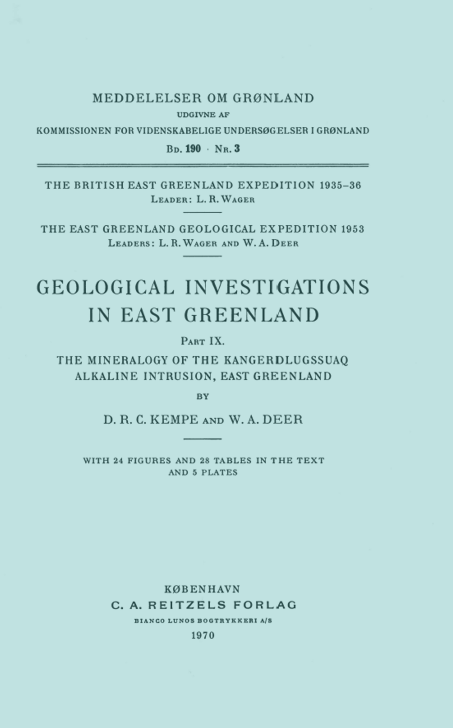Geological Investigations in East Greenland. Part IX.
DOI:
https://doi.org/10.7146/mog.v190.150329Abstract
The constituent minerals of the Kangerdlugssuaq alkaline intrusion are systematically described, with 28 full analyses and additional partial and X-ray analyses. The main mineral of the intrusion, alkali feldspar, is a low-albite-orthoclase or low-albite-microcline microperthite, of composition ranging from Or38 in the nordmarkites, Or36 in the transitional pulaskite, and Or41 in the main pulaskite to Or55 in the foyaite. The nordmarkites and transitional pulaskite contain phenocrysts of low-albite-orthoclase microperthite (Or29_ 28). Microperthite phenocrysts, composition Or18, and rich in calcium (up to An12), are also present in the basalt xenoliths. Six full analyses of feldspars are given, together with 13 partial analyses and X-ray compositions from 74 homogenized specimens. The sodic plagioclase rimming the perthites is an albite (An,). Both types of perthitic alkali feldspar are considered to be derived by unmixing from single feldspars of the anorthoclase-sanidine series. There is reasonable agreement
between the structural state of the phenocrysts, seen as progressive (Al,Si) ordering, and the concept of centripetal cooling of the intrusion. In the case of the groundmass feldspars, of which the obliquities have been determined, there is less good correlation. The application of BARTH's geothermometer to the coexisting alkali and plagioclase feldspars indicates temperatures of crystallization of 970° C in the nordmarkites, falling gradually by some 200° to 760° in the foyaite. Three full analyses of nephelines are presented, together with a further 12 compositions from X-ray analysis. The geothermometric temperatures of crystallization
of the nephelines are in agreement with those of the feldspars. The pyroxenes of the intrusion are aegirines and aegirine-augites; seven full analyses are given. The former are present mainly in the pulaskites ( -Ac80) but are also common in the veins cutting both nordmarkites and pulaskites (-Ac90). In the foyaite the pyroxene is a strongly core-and-rim zoned aegirine-augite ( ~ Ac30) and it is also present in veins in the foyaite. The two varieties of pyroxene both contain appreciable ZrO2 and V2O3 , and are rich in MnO. There is textural evidence that in the pulaskites many of the pyroxenes derive, with biotite, from the breakdown of alkali amphibole.
Alkali amphibole is present in the nordmarkites (katophorite) and pulaskites (magnesioarfvedsonite), whilst the veins of both groups contain arfvedsonite. Full analyses of five amphiboles are given; like the pyroxenes they are rich in MnO, and contain lesser amounts of ZrO2• Li2O is also present. The Si/Al IV ratios in both the pyroxenes and amphiboles show a progressive decrease in passing from the outer to the inner units of the intrusion, whilst the iron oxidation ratio rises from the nordmarkites to the pulaskites. In the foyaite, where amphibole is present in negligible amounts, the oxidation ratio decreases markedly in the pyroxene as aegirine is replaced by aegirine-augite, and is accompanied by the crystallization of melanite.
Two full analyses of biotite are given. This mineral is found mainly in the pulaskites and is also rich in MnO. It is the only mineral in the intrusion in which cesium has been detected. The accessory minerals: quartz; sodalite (present as primary crystals with secondary overgrowths); melanite garnet (analysed); iron oxides (limenite in the early-formed rocks, magnetite in the later ones, with some hematite in the pulaskites); sphene; apatite; zircon; perovskite; astrophyllite (analysed); lavenite (analysed); eudialyte-eucolite (analysed); catapleiite (analysed); hiortdahlite; chevkinite; fluorite and analcite are described. The rare zirconium-rich accessory minerals are found mainly in the veins of the pulaskites. The trace element contents of the analysed minerals and some of the analysed rocks are presented. In addition, five important element ratios have been determined for the various mineral groups, some of which (K/Rb; Ba/Sr; Rb/Sr) show a tendency to converge in the foyaite, suggesting equilibration. In some cases, however, they show marked breaks in the transitional pulaskite. The evidence from the element distribution in coexisting minerals in the pulaskites suggests crystallization at equilibrium, under constant external (P,T) conditions.

Downloads
Published
How to Cite
Issue
Section
License
Coypyright by the authors and the Commision for Scientific Research in Greenland. No parts of the publications may be reproduced in any form without the written permission by the copyright owners.

